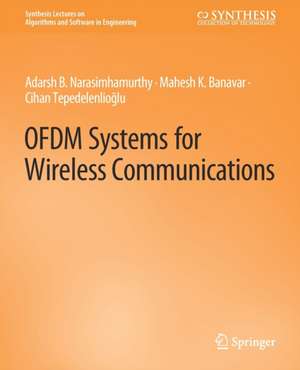OFDM Systems for Wireless Communications: Synthesis Lectures on Algorithms and Software in Engineering
Autor Adarsh Narasimhamurthy, Mahesh Banavar, Cihan Tepedelenliougluen Limba Engleză Paperback – 2 mar 2010
Din seria Synthesis Lectures on Algorithms and Software in Engineering
-
 Preț: 380.37 lei
Preț: 380.37 lei -
 Preț: 260.95 lei
Preț: 260.95 lei -
 Preț: 384.31 lei
Preț: 384.31 lei -
 Preț: 351.11 lei
Preț: 351.11 lei -
 Preț: 262.47 lei
Preț: 262.47 lei -
 Preț: 206.29 lei
Preț: 206.29 lei -
 Preț: 192.63 lei
Preț: 192.63 lei -
 Preț: 206.29 lei
Preț: 206.29 lei -
 Preț: 261.91 lei
Preț: 261.91 lei -
 Preț: 192.05 lei
Preț: 192.05 lei -
 Preț: 204.76 lei
Preț: 204.76 lei -
 Preț: 204.76 lei
Preț: 204.76 lei -
 Preț: 379.48 lei
Preț: 379.48 lei -
 Preț: 414.65 lei
Preț: 414.65 lei -
 Preț: 389.88 lei
Preț: 389.88 lei -
 Preț: 205.92 lei
Preț: 205.92 lei -
 Preț: 260.56 lei
Preț: 260.56 lei -
 Preț: 207.83 lei
Preț: 207.83 lei -
 Preț: 266.70 lei
Preț: 266.70 lei -
 Preț: 381.43 lei
Preț: 381.43 lei
Preț: 192.41 lei
Nou
Puncte Express: 289
Preț estimativ în valută:
36.83€ • 40.02$ • 30.96£
36.83€ • 40.02$ • 30.96£
Carte tipărită la comandă
Livrare economică 21 aprilie-05 mai
Preluare comenzi: 021 569.72.76
Specificații
ISBN-13: 9783031003851
ISBN-10: 3031003853
Ilustrații: X, 68 p.
Dimensiuni: 191 x 235 mm
Greutate: 0.15 kg
Editura: Springer International Publishing
Colecția Springer
Seria Synthesis Lectures on Algorithms and Software in Engineering
Locul publicării:Cham, Switzerland
ISBN-10: 3031003853
Ilustrații: X, 68 p.
Dimensiuni: 191 x 235 mm
Greutate: 0.15 kg
Editura: Springer International Publishing
Colecția Springer
Seria Synthesis Lectures on Algorithms and Software in Engineering
Locul publicării:Cham, Switzerland
Cuprins
Introduction.- Modeling Wireless Channels.- Baseband OFDM System.- Carrier Frequency Offset.- Peak to Average Power Ratio.- Simulation of the Performance of OFDM Systems.- Conclusions.
Notă biografică
Adarsh Narasimhamurthy is a Ph.D. candidate at the School of Electrical, Computer and Energy Engineering in Arizona State University, Tempe. He obtained his B.E. with distinction in 2005 from the Bangalore University, Karnataka, India and the M.S. degree in Electrical Engineering from Arizona State University, Tempe in 2007. Currently, he is a part of the Signal Processing for Wireless Communications Lab headed by Dr. Cihan Tepedelenlio˘glu and also a member of the SenSIP consortium. Mr. Narasimhamurthy was awarded a Research Assistantship in the year 2006 and the subsequent year a Graduate Teaching Associate position from the Department of Electrical Engineering. His research interests include MIMO systems, OFDM systems, reduced complexity diversity combining techniques and multiuser communication. Mr. Narasimhamurthy is also a member of the Eta Kappa Nu honor society and an IEEE student member. Mahesh K. Banavar received the B.E. degree in telecommunications engineering from Visvesvaraya Technological University, Karnataka, India, in 2005 and the M.S. degree in electrical engineering from Arizona State University, Tempe, in 2008. He is pursuing the Ph.D. degree with Arizona State University, specializing in Signal Processing and Communications, and doing research in wireless communications and sensor networks. Mr. Banavar is a member of the Eta Kappa Nu electrical and computer engineering honor society. Cihan Tepedelenlioglu was born in Ankara, Turkey in 1973.He received his B.S. degree with highest honors from Florida Institute of Technology in 1995, and his M.S. degree from the University of Virginia in 1998, both in Electrical Engineering. From January 1999 to May 2001 he was a research assistant at the University of Minnesota, where he completed his Ph.D. degree in Electrical and Computer Engineering. He is currently an Associate Professor of Electrical Engineering at Arizona State University. He was awarded the NSF (early) Career grant in 2001, and has servedas an Associate Editor for several IEEE Transactions including IEEE Transactions on Communications, and IEEE Signals Processing Letters.
